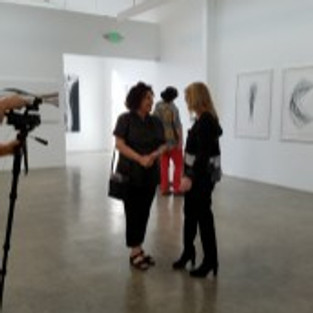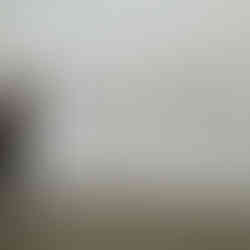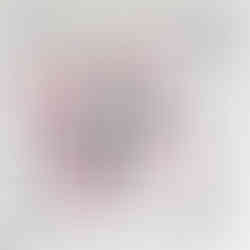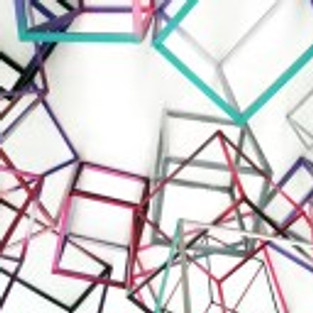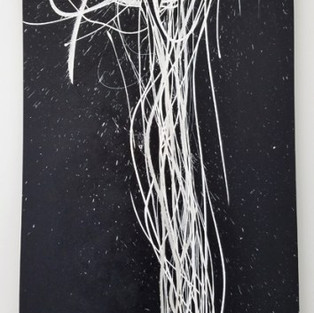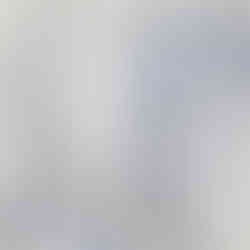
A.M. Rousseau, Lines of Inquiry at Jason Vass. Photo credit: Kristine Schomaker.
A.M. Rousseau at Jason Vass
on view through June 2 with an artist talk/book signing 2pm
By Genie Davis
In A.M. Rousseau’s Lines of Inquiry, viewers see a powerful solo show that vibrates with a range of motion that travels from a quivering delight to a fierce, almost frenzied whirlwind. Rousseau has said she was inspired by Paul Klee’s statement to “Take a line for a walk, aimlessly for the sake of the walk,” but what Rousseau has done here is take her lines on a race.
The mutability of her work, the hieroglyphic nature of her patterns, the shifting use of ink, colored pencil, and acrylic on canvas all add a mysterious, sweetly seething undercurrent to her work. The wide range of her media, and her exploration of lines in so many different formats and permutations is like a wonderful obsession, into which she pulls each viewer.
Some of her compositions are dense, dark; some are filled with space and a kind of light that fills in those spaces. It does not get much denser than her acrylic on canvas “Black Chalice,” in which a dripping swirl of white lines – it could be a tree, the top of a tornado, a night flower about to bloom – descends against a black background. Her “Chalice Tryptych” offers three swirling, similarly patterned creations; taken together, the images on the triptych seem as if they are dancing. Her “Chalice Drawing” is a dark black ink on paper work with a dense concentration of concentric lines about the top, and what could be a dark figure almost etched inside of the image’s “trunk.” It reminds one of a carved image in a tree, or a person caught inside a funnel cloud.
The color – rich in reds and pinks – of “Rush,” created with color pencil, ink, and acrylic on rag paper, is almost a startling contrast. With a white line slashing through the middle, it evokes the open spine of a book, the lines a blur of pages. It also evokes an audio track played and recorded, as do the curved, feather-like images in “The Thin Red Line I” and “The Thin Red Line II,” both also ink and colored pencil on paper. These could be the readings on a recording studio monitor, they could be grasses floating and bending in a breeze, they could be bird feathers or horse tails. With plenty of space between the lines and some thicker and some thinner, these pieces feel like much lighter works, not just in terms of palette but in terms of meaning.
“Collision Course II,” acrylic on canvas, is a thick intertwining of colored lines. Ribbons of color surge from each end of the canvas, meeting in the middle in a ball or fish like shape that could be the confluence of two rivers, or meeting of mysterious kinetic energy in a potent, normally unseen energy field. Works such as “Left Leaning” and “DNA Twist” resemble wires, twined; these ink and ebony pencil works offer curved, twisted black lines that are abruptly, cleanly sheared off at top and bottom. In contrast, her “Center Loop,” employing the same medium, feels more freely formed, a curved collection of lines with a messy, free-form top and neatly sheared bottom separated like the tail of a fish.
“Torch Quartet,” is a bright, curvy series of lines, the top sections of which resemble a skirt uplifted in an unseen wind, while the bottom section could be dancers’ legs poised to take a step, or the roots of wavering flowers.
Rousseau’s “Perspective Collective” sketches I, II and III are geometric forms, lines tamed, created in the most muted yet perfect colors which almost dissolve into the paper on which they are drawn; they are ghost shapes. These look like the patterns for stained glass, puzzles, mathematical constructs visualized. In contrast, in her “Spiral Quartet,” acrylic on board, we see circular, almost conjoined shapes that could be flowers ready to open or balls of yarn.
One of the gifts Rousseau’s work offers viewers is the ability to literally and figuratively be sucked into it – pulled intrinsically into a world that defies easy meaning and yet is compelling to explore. These lines lead us not so much on, but into a vision both precise and undefined, of movement temporarily stilled, allowing us the potential to at least briefly enter the whirlwind.
Lines of Inquiry, A.M. Rousseau
Jason Vass 1452 E. Sixth Street Los Angeles, CA 90021
Closing Reception, Artist Talk and Book Signing on June 2nd @ 2pm.
Gallery Hours:Tuesday – Saturday // 11 – 6pm.
#losangeles #femaleartist #losangelesartist #art #painting #contemporaryart #southerncalifornia #abstract #artgallery #AnnMarieRousseau #gallery #artandcake #artopening #assemblage #artexhibition #installation #ArtandCakeLA #fineart #artists #soloshow #mixedmedia #environment #sculpture #artmagazine #ArtandCulture #exhibition #JasonVassGallery #LinesofInquiry #jasonvass #AMRousseau #graphite #exhibit #dtla #drawing


















